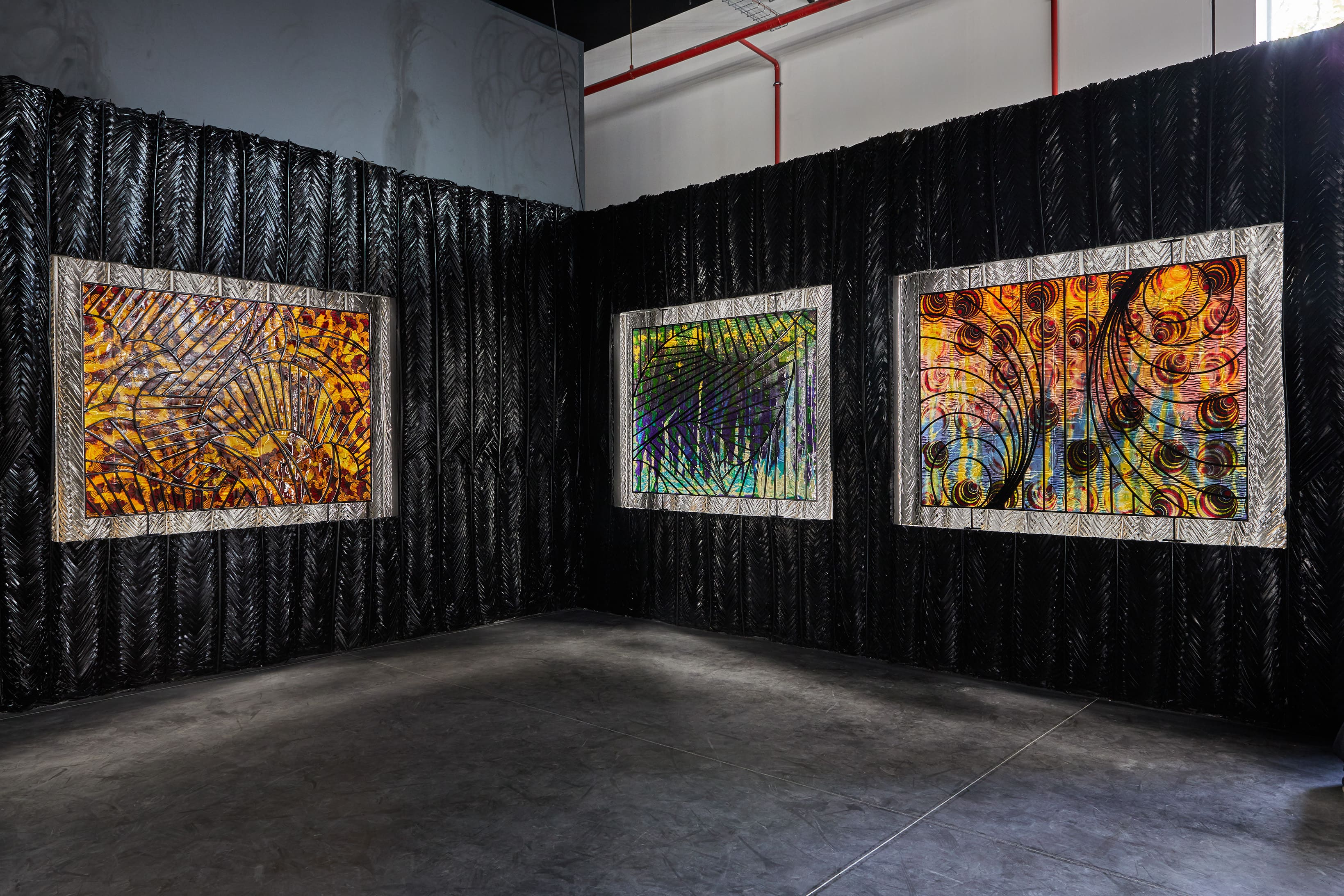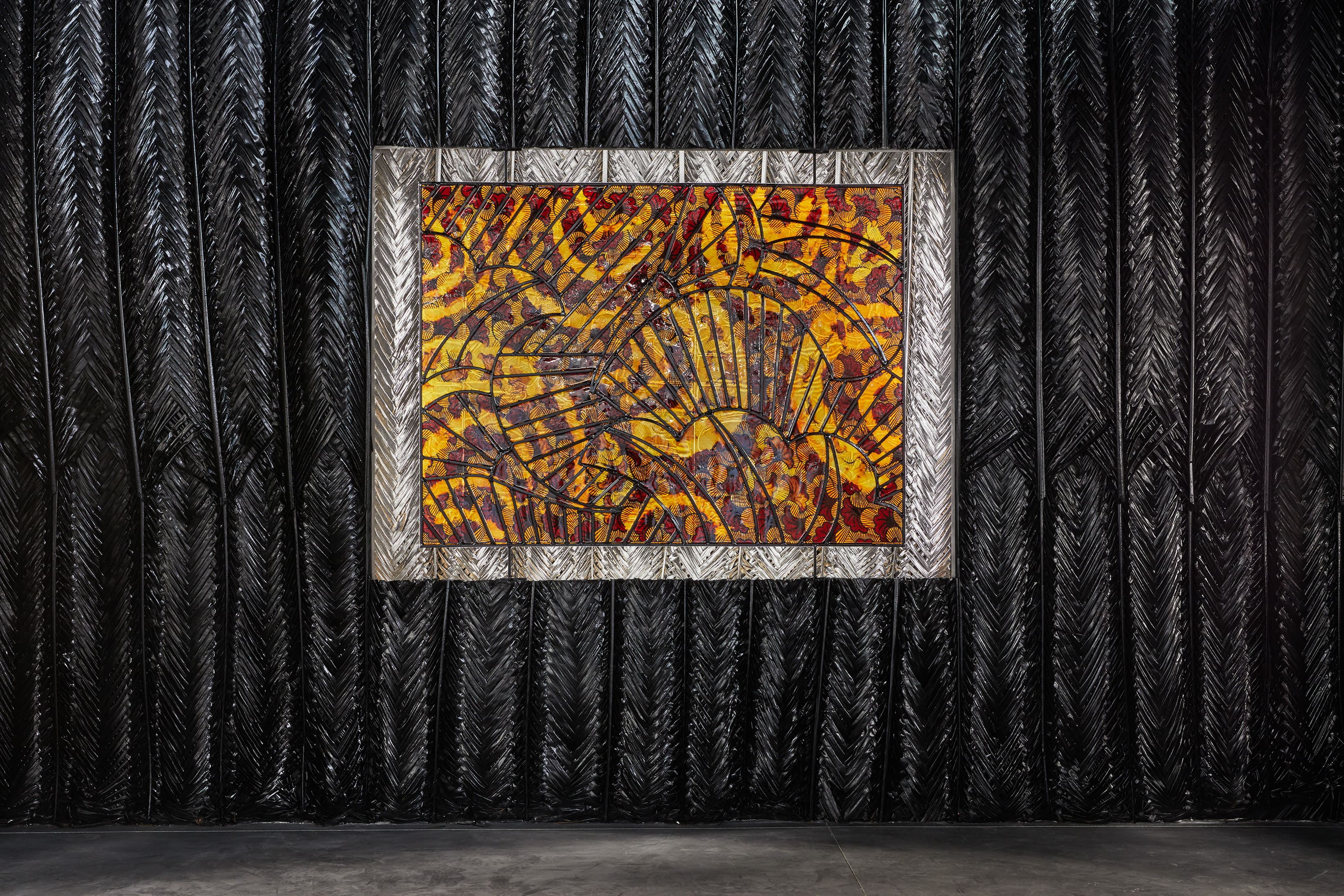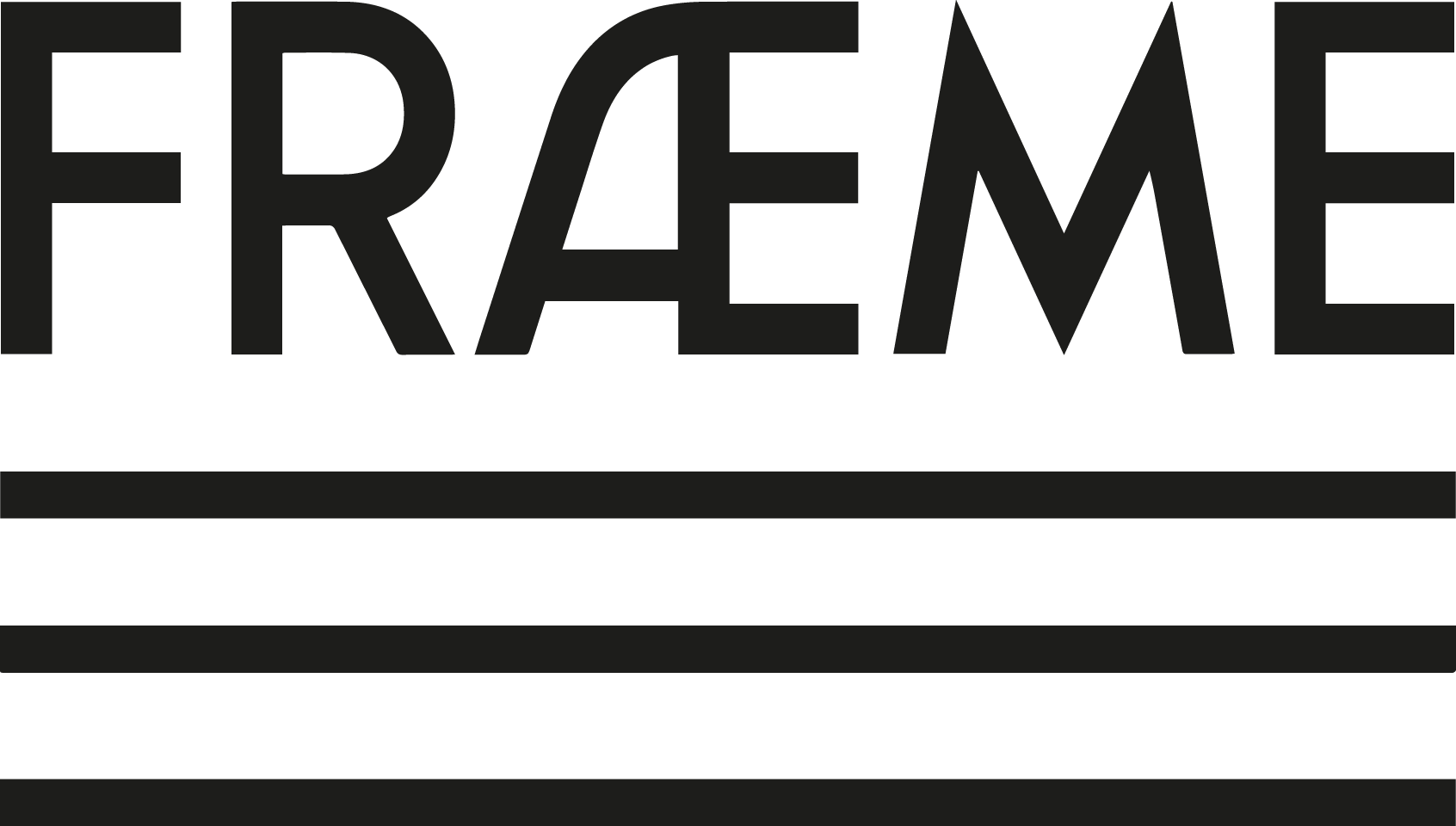Amandine Guruceaga
L’œil de ma rivale I
L’œil de ma rivale II
Fleur de mariage
Chérie ne me tourne pas le dos
Génito
Acier, wax, résine, feuilles de palmiers tressées / Steal, wax, resin, braided palm leaves


© Photos : Jean-Christophe Lett
Porter une « fleur de mariage », surveiller « l’œil de ma rivale », apparaître en « Génito », dire « chérie ne me tourne pas le dos », sont autant de messages envoyés aux proches, à un mari, à la société en général dès lors que l’on souhaite se marier, quand on éprouve les affres de la jalousie, si l’on s’affirme comme force de la nature et géniteur fantasmé ou encore lorsque l’on réclame de l’amour et de l’attention.
Ces mots, ici couchés sur le papier, sont les significations données à des motifs dupliqués sur les waxs. à chaque textile son dessin sui generis porteur de message. Arborer telle étoffe plutôt que telle autre est une manière d’affirmer son état d’esprit, son envie, son urgence et sa culture.
La communication prend parfois des chemins singuliers et Amandine Guruceaga, dès les prémices d’une œuvre en train de se faire, relève, dans la singularité des chroniques relatant la puissance du wax, d’abord britannique, puis largement néerlandais alors que commercialisé en Afrique Subsaharienne, le creuset d’une histoire des hommes et de leurs relations de pouvoir.
Intitulé Lady Rosebud, le projet protéiforme d’Amandine Guruceaga est né de sa résidence passée en Côte d’Ivoire, au cœur du domaine de Tiassalé, le titre étant une citation au bateau convoyeur de marchandises qui relie le continent africain à l’Europe.
L’artiste associe les tissus, messagers de l’intime, aux grilles nommées fort justement les « anti-vols », qui sont apparus sur les façades des nouvelles villes coloniales d’Afrique afin d’en protéger les occupants tout en affirmant leur richesse, en contraste aux architectures vernaculaires largement ouvertes à la communauté.
L’assemblage du métal au tissu, du motif apparu d’abord par l’effort des soudeurs, les structures métalliques affichant fièrement leurs missives, lesquelles, couplées au wax lui-même, présentent leur message comme altéré, produisant une forme de vitrail hybridé, un mixage de matériaux en forme de bas-relief, une alchimie ajourée, un objet hésitant entre son utilité et sa préciosité, une anomalie.
Lady Rosebud, série d’œuvres ici présentées, s’approprie une forme modifiée d’habitat traditionnel, où les papeaux (papo) qui leur sont empruntés emportent le visiteur au cœur du vernaculaire. « L’histoire est inscrite dans la matière » nous dit Amandine Guruceaga, et Lady Rosebud de nous raconter celle de sa résidence, du travail réalisé en collaboration avec les mécaniciens du domaine de Tiassalé, de cette rencontre avec un territoire plus vaste encore que constitue le paysage de Côte d’Ivoire, habité par des femmes et des hommes, incarné dans une culture puissante et héritière des soubressauts du passé. L’échange a eu lieu, une alchimie, qui ne dénature en rien mais plutôt déplace, s’est opérée par la lente élaboration des formes et des matières, elle est ainsi fidèle à sa pratique artistique qui traverse les frontières autant plastiques que géographiques.
Wearing a “wedding flower”, checking on “my rival’s eye”, appearing as a “Genito”, saying “honey don’t turn your back at me”, are as many messages sent to relatives, to a husband, to society in general as soon as one wishes to get married, when one experiences the torments of jealousy, if one affirms itself as a force of nature and fantasized genitor or even when one is asking for love and attention.
These words, here on paper, are the meanings given to patterns duplicated on the Wax fabrics. Each textile has its sui generis design holding a message. Wearing either one cloth or another is a way of expressing one’s state of mind, its desires, emergency and culture.
The communication sometime takes a unique path and Amandine Guruceaga, from the beginning of a work being done, reveals, in its singularity, chronicles relating of Wax’s power, at first British, and then more broadly Dutch while being marketed in Sub-Saharan Africa, the melting pot of Human’s history and their relation to power.
Entitled Lady Rosebud, Amandine Curuceaga’s protean project arose in here residency in Ivory Coast, in the heart of Tiassalé domain, the title being a quote to the goods boat conveyer that connects Africa to Europe. The artist links the fabrics, messengers of the intimate, to the grilles strongly named the “antithefts”, who appeared on the facades of the new African colonial cities to protect the occupants as well as asserting their wealth, contrasting the vernacular architectures widely open to the community.
The assemblage of metal to fabric, of the pattern first appearing with the welders’ efforts, the metallic structures proudly displaying their missives, who, coupled to Wax itself, presents their message as being altered, producing a hybrid stained-glass, a blend of materials with a bas-relief shape, an elegant alchemy, an object hesitating between its use and preciousness, an anomaly.
Lady Rosebud, a series of works presented here, appropriates a modified form of traditional habitat, where the papo borrowed takes the visitor to the heart of the vernacular. “The story is written in the material” tells us Amandine Guruceaga, and Lady Rosebud tells us the one of her residency, the work done in collaboration with the mechanics of the Tiassalé domain, of this meeting with a territory still larger than the landscape of Ivory Coast, inhabited by women and men, embodied in a powerful culture and heir to tremors of the past.
The exchange took place, an alchemy that does not denature in any way but moved, was operated by the slow development of forms and materials, it is so true to her artistic practice that crosses the borders as plastic as geographical.

© Photos : Nina Mouvant
